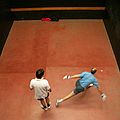Our website is made possible by displaying online advertisements to our visitors.
Please consider supporting us by disabling your ad blocker.
Net and wall games
Net and wall games are court games where either a net separates the opponents or a wall serves to reflect the ball to the opponent. The object of these games is to hit or throw the ball or bird over the net or against the wall back to the opponent. Play typically begins with one side serving the ball/bird by initially tossing or releasing it and then hitting/throwing it over the net or to the wall. This then starts a rally, in which the sides alternate hitting/throwing the ball/bird. Players then score points whenever the opponent fails to return the ball/bird back. The criteria on what is considered a valid return varies between each sport (such as the number of times the ball may be touched or bounced on a player's side before it must go back).[1]
Sports like Real tennis, Padel and Wallyball use both net and walls.
Some sports like Four square, Ballon au poing, Tamburello and Roundnet has the same logic of wall games using the floor or trampoline in the rebounding function.
The Los Angeles Daily Times reports: "Net sports are unique in that the equipment is light, portable and affordable, and partners and opponents are easy to find. The sports are easy to learn, and the social aspect of the game[s] appeals to those who find the health club to be an isolationist palace of mirrors."[2]
Net and wall games usually include:[2][3][4]
- racquet sports such as tennis, badminton, pickleball, table tennis, squash, racquetball.
- volleyball, crossnet, footvolley, Jokgu, headis, roundnet, American handball, Throwball or sepak takraw, where players must hit/throw the ball with the body.
- Some sports like Basque pelota include both the use of hands and the use of equipment depending on the discipline.
The three most popular net and wall games (tennis, badminton, and volleyball) usually involve arching of the back when serving or spiking/smashing the ball or bird.[4]
Although basketball, hockey, water polo, Football and other sports have netting around the goal area designed to more clearly indicate when goals are scored, they are not considered "net games", since the net is not used to separate the teams involved. Similarly, lacrosse sticks have a loose netting that is used to catch and fling the ball, but again lacrosse is not considered a "net game".
-
A volleyball match between Italy and Russia in 2005.
-
Throwball
-
Women playing tennis at the 2007 US Open.
-
Fives
-
A game of squash.
-
Jai alai.
-
Wallyball
-
Padel
- ^ "Best Pickleball Paddles". Retrieved 15 June 2015.
- ^ a b Los Angeles Daily News (October 20, 1995). "More people rushing the nets: Badminton, volleyball, tennis offer muscle-building workouts". The Spokesman-Review. p. C6. Retrieved 5 July 2010.
- ^ Mohnsen, Bonnie S. (2008). "Unit 4: Team Net Sports". Teaching middle school physical education: a standards-based approach for grades 5-8. Human Kinetics. p. 495. ISBN 9780736068499. Retrieved 5 July 2010.
- ^ a b Hall, Hamilton (1994). The New Back Doctor. Random House of Canada. p. 229. ISBN 9780770426194. Retrieved 5 July 2010.
Previous Page Next Page










